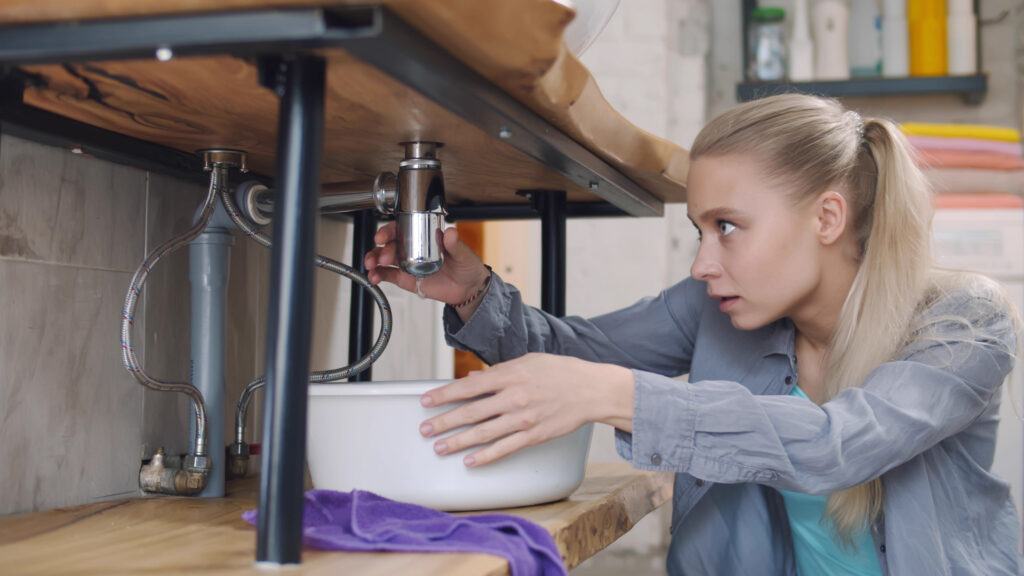Why Is My Sink Disposal Not Working?

A sink disposal is one of those kitchen conveniences you don’t think about—until it stops working. Whether it’s grinding away food scraps or keeping your sink clog-free, a well-functioning disposal makes life easier. But when it suddenly stops working, makes strange noises, or just won’t turn on, it can be frustrating.
Don’t worry, though! There are a few common reasons why your garbage disposal might be acting up, and many of them are easy to fix. In this guide, we’ll walk through the signs that something’s wrong and what you can do to get it running smoothly again.
Table of Contents
Common Reasons Your Sink Disposal Isn’t Working
Before you panic and start thinking about replacing your garbage disposal, it’s worth checking out some common issues that could be causing it to stop working. In many cases, a simple fix can get things running smoothly again. Whether it’s a power issue, a jam, or even a dull blade, let’s break down some of the most frequent reasons your sink disposal might not be working—and what you can do about it.
Power Issues
Sometimes, the problem is as simple as the disposal not getting power. It might seem obvious, but you’d be surprised how often the unit gets accidentally unplugged or a circuit breaker trips without you realizing it. First, check if the disposal is securely plugged into the outlet under the sink. If it is and still not working, head to your breaker box and see if the switch has flipped.
Another quick fix? The reset button! Most garbage disposals have a small red or black reset button on the bottom. If it’s popped out, press it back in and try running the disposal again. This little trick can often solve the problem in seconds.
Jammed Disposal
If your disposal is making a humming sound but not actually grinding anything, it’s likely jammed. This usually happens when things like bones, fibrous foods (think celery or potato peels), or even non-food objects (oops, that spoon!) get stuck inside.
The good news? You can often fix this yourself. First, turn off the power to the unit—safety first! Then, use an Allen wrench (most disposals come with one) to manually turn the blades from the bottom of the unit. If you don’t have the wrench, a wooden spoon handle can sometimes help dislodge debris from above. Once it’s freed up, run some water and test it out.
Clogged Drain
A clogged drain can mimic disposal problems by causing water to back up in the sink. If you notice slow draining or standing water, food debris may have built up in the pipes.
To tackle this, avoid using harsh chemical drain cleaners that could damage your pipes and the disposal itself. Instead, try flushing with a mixture of baking soda and vinegar, followed by hot water. A plunger can also help break up minor clogs without putting too much pressure on your plumbing system.
Worn or Dull Blades
Over time, your disposal’s blades can wear down, making it harder to break down food scraps efficiently. If you notice that food isn’t grinding up as easily or you hear a lot of rattling inside the unit, dull blades might be the culprit.
An easy fix? Try grinding ice cubes or citrus peels to help sharpen the blades and freshen things up at the same time. If that doesn’t do the trick, it might be time to consider replacing the blades or the unit altogether.
Motor Failure
If your disposal isn’t making any noise at all—no humming, no grinding—it could mean the motor has burned out. This can happen with older units or if the disposal has been overworked by grinding tough materials repeatedly.
When the motor goes, it’s often more cost-effective to replace the disposal rather than repair it. Newer models are more efficient and quieter, so while it’s a hassle, it might be a good opportunity to upgrade to something better suited for your needs.
By understanding these common issues, you can troubleshoot your garbage disposal with confidence and maybe even avoid a costly repair call. If you’ve tried all the quick fixes and your disposal is still giving you trouble, it might be time to call in a pro.
DIY Fixes for a Non-Working Garbage Disposal
Before calling in a plumber, there are several simple DIY fixes you can try to get your garbage disposal back in working order. Most of the time, the issue is something minor that you can handle yourself with a few basic tools and a little know-how. Let’s go through some easy steps to troubleshoot and fix your disposal safely.
1. Safety Precautions Before Troubleshooting
First things first—safety is key! Garbage disposals may seem harmless, but they involve sharp blades and electrical components, so it’s important to take a few precautions before getting your hands in there.
- Turn off the power: Always unplug the disposal from the outlet under the sink or switch off the circuit breaker to prevent any accidental activation.
- Never use your hands: It’s tempting to reach in and grab whatever’s causing the problem, but resist! Instead, use tools like tongs or pliers.
- Keep water running: When testing the disposal, always run cold water to help flush out debris and prevent overheating.
2. Step-by-Step Guide to Resetting the Disposal
Sometimes all your garbage disposal needs is a simple reset to get back on track. If it’s not turning on or making any noise, follow these steps:
- Locate the reset button: Look underneath the disposal unit for a small red or black button—this is your reset switch.
- Press the reset button: If it’s popped out, press it firmly back in until you feel a click.
- Try the disposal again: Turn on the power and flip the disposal switch to see if it starts working.
- Repeat if needed: If it trips again right away, it may indicate a larger issue like a jam or motor failure.
3. How to Manually Rotate the Blades with an Allen Wrench
If your disposal is making a humming noise but isn’t spinning, it’s probably jammed. Luckily, most disposals are designed with a built-in fix using an Allen wrench (also called a hex key).
Here’s how to do it:
- Turn off the power: Again, safety first—unplug the unit or turn off the breaker.
- Find the hex socket: Under the disposal, you’ll see a small hex-shaped hole in the center.
- Insert the Allen wrench: Use the wrench that came with your disposal (or a standard 1/4-inch Allen wrench) and turn it back and forth a few times to manually free up the blades.
- Check for looseness: Once it moves freely, remove the wrench, turn the power back on, and test the disposal.
If you don’t have an Allen wrench, a wooden spoon or broom handle inserted from the top can sometimes help dislodge blockages as well.
4. Home Remedies to Break Down Minor Clogs
If your disposal is running but water is draining slowly, you might be dealing with a minor clog. Instead of reaching for harsh chemical drain cleaners, try these simple and effective DIY solutions:
- Baking soda and vinegar: Pour ½ cup of baking soda into the disposal, followed by 1 cup of vinegar. Let it fizz and work its magic for 10-15 minutes, then flush with hot water.
- Ice cubes and salt: Toss a handful of ice cubes and a few tablespoons of salt into the disposal. Run it with cold water to help clean the blades and break down any stubborn buildup.
- Dish soap and hot water: Fill the sink with hot, soapy water and let it drain while running the disposal. This can help remove grease and debris.
These remedies not only help clear minor blockages but also keep your disposal smelling fresh and running smoothly.
When to Call a Professional
If you’ve tried all the DIY fixes and your garbage disposal is still not working, it might be time to call a professional. Persistent issues like repeated jams, strange noises, or frequent resets could indicate a deeper problem that requires expert attention.
Electrical concerns, such as flickering power or water leaks near wiring, should always be handled by a licensed technician to avoid safety risks.
Additionally, if repairs are becoming costly, it may be more budget-friendly to replace the unit with a newer, more efficient model. A professional can help you determine the best course of action.
Preventative Maintenance Tips
Taking care of your garbage disposal can help extend its lifespan and keep it running efficiently. With a few simple habits, you can prevent jams, clogs, and costly repairs. Here’s how to keep your disposal in top shape.
1. Proper Use to Avoid Jams and Clogs
Using your garbage disposal correctly is the first step to preventing problems. Always run cold water while using the disposal to help flush food particles through the system and avoid grease buildup. Feed food waste gradually instead of dumping large amounts all at once, which can overload the unit and lead to jams. Also, be mindful of the types of foods you’re grinding—avoid fibrous or starchy items that can tangle the blades or create clogs.
2. Routine Cleaning Techniques
Regular cleaning helps prevent odors and buildup inside your disposal. A simple method is to grind ice cubes and rock salt to help remove stuck-on debris and sharpen the blades. You can also freshen up the disposal by pouring a mixture of baking soda and vinegar down the drain, letting it sit for a few minutes, and then flushing it with hot water. For a pleasant scent, grinding citrus peels can leave your sink smelling fresh.
3. Items to Avoid Putting in the Disposal
Not everything belongs in the garbage disposal, and avoiding certain items can prevent damage and costly repairs. Steer clear of fibrous foods like celery, corn husks, and onion skins, which can tangle the blades. Starchy items like pasta, rice, and potato peels can expand and clog the pipes. Hard materials such as bones, fruit pits, and coffee grounds can wear down the blades or clog the drain. And, of course, never pour grease or oil down the disposal, as it can solidify and cause blockages.
Preventative Maintenance Tips
Taking care of your garbage disposal can help extend its lifespan and keep it running efficiently. With a few simple habits, you can prevent jams, clogs, and costly repairs. Here’s how to keep your disposal in top shape.
Proper Use to Avoid Jams and Clogs
Using your garbage disposal correctly is the first step to preventing problems. Always run cold water while using the disposal to help flush food particles through the system and avoid grease buildup. Feed food waste gradually instead of dumping large amounts all at once, which can overload the unit and lead to jams. Also, be mindful of the types of foods you’re grinding—avoid fibrous or starchy items that can tangle the blades or create clogs.
Routing Cleaning
Regular cleaning helps prevent odors and buildup inside your disposal. A simple method is to grind ice cubes and rock salt to help remove stuck-on debris and sharpen the blades. You can also freshen up the disposal by pouring a mixture of baking soda and vinegar down the drain, letting it sit for a few minutes, and then flushing it with hot water. For a pleasant scent, grinding citrus peels can leave your sink smelling fresh.
Items to Avoid
Not everything belongs in the garbage disposal, and avoiding certain items can prevent damage and costly repairs. Steer clear of fibrous foods like celery, corn husks, and onion skins, which can tangle the blades. Starchy items like pasta, rice, and potato peels can expand and clog the pipes. Hard materials such as bones, fruit pits, and coffee grounds can wear down the blades or clog the drain. And, of course, never pour grease or oil down the disposal, as it can solidify and cause blockages.
By following these preventative maintenance tips, you can keep your garbage disposal running smoothly and avoid unexpected breakdowns.
Conclusion
A well-functioning garbage disposal is a kitchen essential, making cleanup easier and keeping your sink free of food waste. If your disposal isn’t working, common issues like power problems, clogs, or jams can often be fixed with simple troubleshooting steps. Remember to follow safety precautions, try DIY solutions like resetting the unit or manually freeing the blades, and keep up with regular maintenance to prevent future issues.
Addressing disposal problems early can save you from expensive repairs or replacements down the line. If DIY efforts don’t solve the problem, don’t hesitate to call a professional to avoid further damage or safety hazards. With proper care and use, your garbage disposal can provide years of reliable service.
FAQs
Why does my garbage disposal make a humming noise but not work?
If your disposal is humming but not grinding food, it’s likely jammed. This usually happens when something like a hard object (utensils, bones, or tough food scraps) is stuck in the blades, preventing them from turning. To fix this, turn off the power and use an Allen wrench to manually rotate the blades from the bottom of the unit. If the disposal still doesn’t work, the motor may have overheated or burned out, requiring professional repair or replacement.
Can I use chemical drain cleaners in my disposal?
It’s not recommended to use chemical drain cleaners in your garbage disposal. These chemicals can damage the disposal’s components, including the rubber seals and metal parts, leading to leaks or reduced lifespan. Instead, opt for natural solutions like baking soda and vinegar or use a plunger to clear minor clogs safely. If the clog persists, consider professional assistance to avoid damaging the unit.
How long should a garbage disposal last?
On average, a well-maintained garbage disposal can last anywhere from 8 to 15 years. Its lifespan depends on how often it’s used, the types of materials put into it, and regular maintenance habits. To extend the life of your disposal, avoid grinding hard or fibrous materials, clean it routinely, and address minor issues promptly before they turn into bigger problems.
Additional Home Improvement Resources

Anna has over six years of experience in the home services and journalism industries and serves as the Content Manager at MyHomePros.com, specializing in making complex home improvement topics like HVAC, roofing, and plumbing accessible to all. With a bachelor’s degree in journalism from Auburn University, she excels in crafting localized, comprehensive guides that cater to homeowners’ unique needs. Living on both coasts of the United States has equipped her with a distinctive perspective, fueling her passion for turning any house into a cherished home through informed, personalized decision-making.








